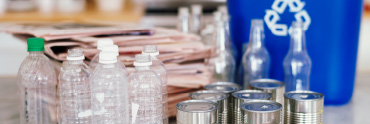Continuing Reflections on NERC & Recycling
Cynthia L. Greene, Manager of US EPA New England, Energy and Climate Unit, continues our series of guest blogs by people who have been influential in NERC's history.
When did you first become involved with NERC and how long were you actively involved?
1990 to 2006
How did you first get involved with NERC?
On a paper recycling study and as a grant project officer.
What were you "doing" then, and what you're doing now?
I was the team leader for solid waste at EPA New England and managing all of the solid waste grant dollars. I now am the manager of the Energy and Climate Unit at EPA New England.
What are some of your fondest memories of NERC?
NERC quarterly meetings and the fruitful exchange between the states, working with the Direct Marketing Association and the Post Office on recycling, the ground breaking work on determining the economic benefits of recycling, and the venture forums.
What do you consider to be NERC's greatest strengths? Greatest achievements?
The dedicated and creative staff and members. ONP - newspaper publishers'…
Recycling Notes of Traveling NERC Staff
I'm sure professionals in a lot of fields take pictures relating to their jobs while on vacation. I know I do! I have always found examples of trash, recycling, and composting in other parts of our country or the world to be interesting.
I had the privilege of recently spending six days in the City of Vancouver, British Columbia. While walking around I noticed that paper set out for curbside collection was placed in plastic bags, while hard recyclables went in the blue box. Reading about the program, I discovered that Vancouver's Blue Box Recycling Program was implemented City-wide in 1990 and now provides service to over 100,000 households. Residents are provided a blue box (for metal, glass and plastic containers), a reusable yellow bag (for mixed paper products) and a reusable blue bag (for newsprint). Residents sort their recyclable materials into the appropriate bag or box and on collection day, set them out for collection. Using reusable bags is undoubtedly a way to hold down costs associated with recycling bin purchases.
More Illuminating Reflections on NERC & Recycling
As we recognize NERC's 25thanniversary, we are continuing our series of guest blogs by people who have been influential in NERC's history. Connie Saulter, was NERC's second Executive Director.
Here's what she has to say.
First of all, I would like to say Congratulations to everyone who has been involved in the Northeast Recycling Council since its inception. That NERC is celebrating its 25th Anniversary speaks volumes to a dedicated number of individuals and agencies who maintained a strong vision of the importance of a public/private partnership toward solid waste/recycling initiatives.
When did you first become involved with NERC and how long were you actively involved?
I joined NERC in the fall of 1990, when NERC consisted of just Shelley Dresser [NERC's 1st Executive Director] and me, and we worked from Shelley's home. When I left in the summer of 1995, NERC had real offices in downtown Brattleboro and four full-time staff.
How did you first get involved in NERC?
Chip…
I put it on the Curb
…Where does it go?
 I've been in the recycling field for more than 20 years and still get asked that question. As an occasional article for the NERC Blog I thought I would showcase companies in the Northeast that use recycled materials in the manufacturing of new products.
I've been in the recycling field for more than 20 years and still get asked that question. As an occasional article for the NERC Blog I thought I would showcase companies in the Northeast that use recycled materials in the manufacturing of new products.
EARTHTEC is a company headquartered in Portsmouth, New Hampshire. EARTHTEC manufactures clothing out of recycled PET bottles. The company has manufacturing facilities around the world, including Portsmouth.
The EARTHTEC Story:
"We build cool clothes that go easy on the planet.
We are outdoor people. Our favorite place is Earth... We're into green.
We eat technical. We breathe comfort. We live fashion.
Our team is made up of apparel industry vets with endless passion for building products made only…
Relections on NERC History by Lois Hager, Former NERC Board Member
NERC is celebrating its 25th anniversary. NERC staff have worked with countless individuals through the years—board members, advisory members, funders, project participants, and others. We set about to identify who we felt were the most influential people in NERC's history. We asked people to share their thoughts about NERC and its history to be posted in the NERC blog. To help them out we asked them a couple questions.
Lois B. Hager was a former NERC Board Member representing the State of Connecticut. Her responses reveal some of NERC's early history.
Tell us about yourself first. When did you first become involved with NERC and how long were you actively involved?
I was one of the original representatives. Victor Bell in RI, John Schall in MA, and I in CT were organizing our state's recycling programs. We decided to try to help each other and met in RI to discuss our programs and needs. This must have been in about 1987 shortly after CT's mandatory recycling act was passed by the legislature. I…
Disasters Strike in Many Ways
When natural disasters hit, of course we immediately feel for the victims. As the days go by, our thoughts continue to be with those who are suffering; however, as solid waste professionals, we can't help but wonder about all the debris generated by the disaster.
While traveling recently in the Pacific Northwest, I was also struck by the longevity of disaster debris and the many ways it can impact us. Debris from last year's devastating earthquake and tsunami that hit Japan began washing up along the coasts of Oregon, Washington, and British Columbia, alarming residents, environmental scientists, and government officials. Some 1.5 million tons of debris is estimated to be heading toward the Pacific Northwest beaches. The primary public concern was that the debris potentially holds invasive species that could pose a serious threat to marine environment and native species. Government official concerns were about how will handling the debris be paid for in today's tightening budgets. Lawmakers in the Northwest are asking for federal emergency assistance, a new twist in emergency management funding. Cleanup costs are unknown, but expected to be high.
The debris, including…
“Harvester” Turns Supermarket Food Waste into Fertilizer
I recently read an interesting article in Environmental Leader about
PCC Natural Markets and its new on-site food scrap "Harvester."
PCC is the nation's largest member-owned grocery retailer, with stores located around the Seattle, Washington area. Its store in Issaquah is hosting the Harvester. The pilot project is in partnership with a local clean technology firm, WISErg Corporation, the developer of the Harvester.
Food scraps from the store are tossed into the sealed Harvester unit. The unit grinds the food scraps and digests the material to create an organic liquid fertilizer that will be sold at the PCC stores.
The pilot has been running for about two months without problems. Washington State University is testing the liquid fertilizer soil amendment properties.
Perhaps we'll see one in the Northeast soon!!
By Athena Lee Bradley
C&D Insights - Recycling vs. Not Recycling
Successful C&D recycling, like other types of recycling, must make economic sense. Effective hauler contract negotiations and accurate record keeping are crucial.
In contract negotiations with a hauler or haulers it is essential that the following information be obtained:
- Tipping rates for landfill disposal;
- Processing fees for all recyclables to be collected;
- Distances to market/recyclers, as well as to the disposal site;
- Hauling costs for both recycling and waste; and
- Any revenue returns for material sales (including both reuse and recycling).
Put this data in a spreadsheet for easy comparison. Negotiating with the hauler may help get some materials hauled at no cost, in return for the hauler keeping revenues (such as metals and cardboard); some materials, such as clean wood can often be hauled at a lower rate. Apply avoided cost calculating—that is, calculate the costs of actually recycling a material vs. what it would have cost to dispose of the same material.
An easy formula for comparing recycling vs. waste disposal:
Number of trash dumpsters x haul rate x tip fee…
Making $ense of C&D Recycling
As with any recycling program it's not enough to have a plan and to know where the materials are going, you have to know the economics of implementing the program. Depending on the markets in your area, waste reduction, reuse, and recycling on the C&D jobsite can result in waste diversion of 60-95%. But does this translate into economic savings for the construction or demolition site? In many instances, yes, especially in areas with relatively high tip fees for solid waste disposal. Economic and diversion data for C&D recycling projects can be found on the Internet; a good source of project analysis is on the WasteCap Resource Solutions'website.
At one WasteCap project, a large construction job (460,000 square feet), completed by Mortenson Construction, achieved a recycling rate of 97.96%. Materials recycled included, metal, wood, concrete, and cardboard. For this $70 million job, 9,588 tons of materials were recycled and $700,000 saved. On another, smaller project, a 90% recycling rate was achieved. This resulted in 231 tons diverted to recycling and a savings of $6,000.
One beneficial way to approach C&D recycling at larger sites is to develop vendor lists and allow…
C&D Recycling - It’s all about the Markets!
Just as with any recyclable material, construction and demolition recycling doesn't happen without markets.
On a demolition or renovation job, markets start with reuse for unwanted or surplus materials. Get buy-in from the project authority and put reuse as a priority in bid specifications and contracts. Select a coordinator for this aspect of the project. On demolition/deconstruction jobs, determine who controls the debris (does it belong to the owner, contractor, deconstruction or reuse person hired, or is it being done solely as a donation project and materials will be given away).
Identify target materials for reuse—including beams, hard wood floors, architectural salvage, doors, hardware, sinks, marble, kitchen cabinets, and light fixtures. (Caution: watch out for items that may contain lead, such as piping). Contact deconstruction or salvage operations, local architectural antique dealers, Materials Exchanges in the Northeast, nonprofit organizations (such as Habitat for Humanity, other building reuse organizations), artists, schools, and other potential reuse outlets. Determine storage needs and timing for removal of materials. A "reuse plan" is helpful to…

